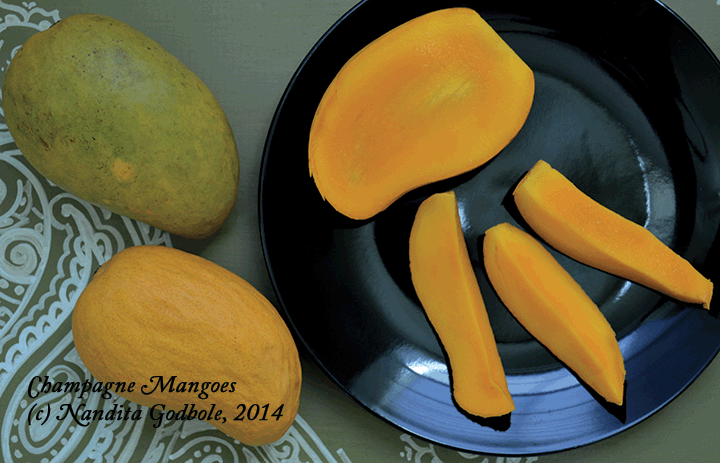Mangoes
Mangoes mangoes everywhere . . . but do you know how to pick ‘em?

Champagne Mangoes: Top left, raw. Bottom left: ripe. Right: Ripe mango cut into wedges.
Spring and summer are, in my vocabulary, generic (and rather boring) names for the official Mango season. My parents still grow the best of the best, the Alphonso mango(which makes me utterly impartial).
Given my unbiased position, I find it heart breaking when markets here don’t carry good mangoes in the season or worse, when people buy a fruit but have to toss it because they did not know how to process it (aka, when is it ripe, how to pick, how to cut etc.) It is the one fruit I sorely miss.
Back to reality . .
How to pick them?
A raw Kent or Alphonso mango looks like a giant avocado, must have smooth dark green skin, may be spotted with golden yellow flecks all over, and have a reddish hue around the stem and the area beneath the stem is just slightly depressed. The color should be uneven, meaning each fruit has seen some sunlight and is ready to be brought home to be ripened. Imagine it hanging off the tree, and seeing some sun – that kind of uneven. There will also be some naturally occurring sap around the stem, or even residue from when the fruit was picked. If it can be scratched off, it is normal. Can I just say that the Alphonso mangoes my parents grow, can weigh between a pound, to a pound and half. Yes, each.
A raw Kent / Champagne® mango will be a golden green, with flecks of yellow. It will have a smooth skin, be oblong in shape, the size of ones’ palm or smaller. Dings or brown spots – not good.
When you buy them...
Although there are several hundred varieties of mangoes, here are some basic, unquestionable DONTS that apply to all varieties of mangoes:
1. Do not be tempted to squeeze the fruit; it only spoils quicker.
2. Do not wash the fruit with water or any other liquid until you are ready to eat, the fruit will spoil. The sap actually protects the fruit. If you are utterly concerned, wipe it down well with a soft dry towel. Water actually invites visitors into the fruit and a washed mango goes from being a vegan fruit to ‘protein enriched’ non-vegetarian product (get the picture?). Yes, just don’t wash it.
3. Do not refrigerate the fruit, again, it will spoil. Unlike the avocado that keeps forever in refrigeration, the mango will not.
4. Do not purchase fruit that is dented, has large brown patches.. it is the result of someone doing the above ‘donts’.
Now what?
My parents still harvest the fruit by hand and place dozens and dozens of fresh fruit under straw to ripen them. This is the best way to ripen a mango. Some growers include gunpowder (yes), or apply chalk or lime to hasten the ripening. These methods are clearly not good because the residue is harmful.
Fresh mangoes must be checked for ripeness before they are cut open. A cut mango will never ripen.
In the absence of straw bales :) store freshly purchased mangoes at room temperature. Kent and Alphonso mangoes can be individually wrapped in newspaper, or paper towels to keep the fruit warm and dry. Cloth towels don’t really help. Champagne® mangoes are best kept uncovered in a draft free area.
An Alphonso or Kent mango will be golden yellow when ripe. Champagne® mangoes are ripe when their skin has wrinkled and the fruit has turned into a soft sunrise yellow. If you cannot tell the difference, take a whiff of the fruit near its stem. A ripe mango will smell sweeter than the rest.
When using fresh mangoes, wash and wipe the fruit thoroughly and remove the stems and the naturally occurring sap around the stems. The fruit is mostly spherical, or may be slightly flattened depending on the variety. Its single large seed sits at the core of the fruit. Kent, Alphonso and Champagne® mangoes are less fibrous than other varieties.
There are two ways to cut a mango – skin on or skin off.
Skin on:
Using a small paring knife, cut away the flesh of each mango going as close to the seed (directly below where the stem was) as possible. Go from top of the fruit (near the stem) to the opposite end, or the tip. You will have two large pieces from either side of the mango, and 2 thin slivers from the remaining, around the main seed. Divide the larger pieces into wedges, and enjoy.
Skin off:
Work over a large bowl, peel away the skin in long sections with a vegetable peeler. Using a small paring knife, cut away the flesh of each mango going as close to the seed (directly below where the stem was) as possible. As you cut away, give the mango a little taste. Dice the flesh into pieces or leave as large wedges. Squeeze out any juices close to the fibrous seed. If you end up with a tart fresh mango – add it to salsa, margarita and such variants.
Got it?
Good.
Here are some recipes on my site that use mangoes:
Quick Mango-Jaggery Salsa

